PUBLIC UTILITIES COMMISSION OF THE STATE OF CALIFORNIA
ID #8946
ENERGY DIVISION RESOLUTION E-4285
November 20, 2009
REDACTED
Resolution E-4285. Pacific Gas and Electric Company
PROPOSED OUTCOME: This Resolution approves cost recovery for two Pacific Gas and Electric Company short-term renewable energy power purchase agreements with PacifiCorp. The power purchase agreements are approved with modifications, subject to a compliance filing.
ESTIMATED COST: Actual costs of these power purchase agreements are confidential at this time.
By Advice Letter 3526-E and Advice Letter 3527-E filed on September 18, 2009.
__________________________________________________________
SUMMARY
Pacific Gas and Electric Company's proposed power purchase agreements with PacifiCorp, as modified by this Resolution, comply with the Renewables Portfolio Standard (RPS) procurement guidelines and are approved, subject to a compliance filing.
Pacific Gas and Electric Company (PG&E) filed Advice Letter (AL) 3526-E and AL3527-E on September 18, 2009 requesting Commission review and approval of renewable energy power purchase agreements (PPAs) executed with PacifiCorp. The PPAs are short-term, bilateral contracts for a portion of the generation from eight wind facilities operating in PacifiCorp's territory. The first PPA (2009 Agreement) is for the period from October 1, 2009 through December 31, 2009. The second PPA (2010 - 2012 Agreement) is for a term from January 1, 2010 through December 31, 2012. The wind facilities included in the PPAs all began operating after January 1, 2005 and are located in Idaho, Washington, and Wyoming.
The PPAs are modified so that the provisions related to the procurement of energy from any "Complying Facility" are not approved. These modifications shall be reflected in a PPA amendment or letter agreement signed by both parties agreeing to the modified terms and submitted as a Tier 1 Advice Letter compliance filing with Energy Division no later than 30 days after approval of this Resolution.
RPS-eligible deliveries from these PPAs, with this modification, are reasonably priced and fully recoverable in rates over the life of the contracts, subject to Commission review of PG&E's administration of the contracts.
The following tables summarize the two agreements.
2009 Agreement
Generating facilities |
Technology Type |
Term |
Minimum Capacity (MW) |
Minimum Energy (GWh) |
Delivery Date |
Location |
1. Wolverine Creek 2. Marengo Wind II 3. Seven Mile Hill I 4. Seven Mile Hill II 5. Glenrock I 6. Rolling Hills 7. Glenrock III |
Wind, operating |
3 months |
100 |
221 |
October 1, 2009 |
Idaho, Washington, and Wyoming |
2010-2012 Agreement
Generating facilities |
Technology Type |
Term |
Minimum Capacity (MW) |
Minimum Energy (GWh) |
Delivery Date |
Location |
1. Wolverine Creek 2. Goodnoe Hills 3. Marengo Wind II 4. Seven Mile Hill I 5. Seven Mile Hill II 6. Glenrock I 7. Rolling Hills 8. Glenrock III |
Wind, operating |
3 years |
100 |
665 in 2010; 665 in 2011; 657 in 2012 |
January 1, 2010 |
Idaho, Washington, and Wyoming |
Confidential information about the contract should remain confidential
This Resolution finds that certain material filed under seal pursuant to Public Utilities (Pub. Util.) Code Section 583, General Order (G.O.) 66-C, and D.06-06-066 should be kept confidential to ensure that market sensitive data does not influence the behavior of bidders in future RPS solicitations.
Pursuant to D.06-06-066 and the decision's Appendix I "IOU Matrix", this Commission adopted a "window of confidentiality" for individual contracts for RPS energy or capacity. Specifically, this Commission determined that RPS contracts should be confidential for 3 years from the date the contract states that energy deliveries begin, except contracts between IOUs and their own affiliates, which should be public.
BACKGROUND
The RPS Program requires each utility to increase the amount of renewable energy in its portfolio
The California RPS Program was established by Senate Bill (SB) 1078 and has been subsequently modified by SB 107 and SB 1036. The RPS program is set forth in Public Utilities (Pub. Util.) Code Sections 399.11-399.20. An RPS is a market-based policy mechanism that requires a retail seller of electricity to increase a certain percentage of electricity in its portfolio that is generated by Eligible Renewable Energy Resources (ERR). Under the California RPS, each utility is required to increase its total procurement of ERRs by at least one percent of annual retail sales per year so that twenty percent of its retail sales are supplied by ERRs by 2010.1
In response to SB 1078 and SB 107, the Commission has issued a series of decisions that establish the regulatory and transactional parameters of the investor owned utility (IOU) renewables procurement program.2
· On June 19, 2003, the Commission issued its "Order Initiating Implementation of the Senate Bill 1078 Renewable Portfolio Standard Program," D.03-06-071.
· In D.03-06-071, the Commission allowed utilities to enter bilateral contracts under certain conditions. In D.06-10-019 the Commission clarified the conditions required under D.03-06-071 and added the requirement that all bilaterals must be submitted to the Commission for approval by advice letter. More recently, in D.09-06-050, this Commission determined that bilateral RPS contracts should be evaluated using the same methods and criteria as are used to review contracts that result from a competitive solicitation.
· Instructions for utility evaluation of each offer to sell ERRs requested in an RPS solicitation were provided in D.04-07-029, as required by Pub. Util. Code Section 399.14(a)(2)(B). The bid evaluation methodology is known as `least-cost, best-fit' (LCBF).
· The Commission adopted standard terms and conditions (STCs) for RPS power purchase agreements in D.04-06-014, as required by Pub. Util. Code Section 399.14(a)(2)(D). These STCs are compiled in D.08-04-009, as modified by D.08-08-028, and as a result there are now thirteen STCs of which four are non-modifiable.
· In D.06-05-039, the Commission required participation of an Independent Evaluator (IE) in the IOU's competitive RPS procurement process. The IE's role is to ensure that the IOU's RPS solicitation is undertaken in a fair, consistent, and objective manner. The IE also provides additional oversight during contract negotiations.
· D.06-10-050, as modified by D.07-03-046, outlined the RPS reporting and compliance methodologies and rules. In this decision, the Commission established methodologies to calculate a load serving entities' (LSE) initial baseline procurement amount, annual procurement target (APT) and incremental procurement amount (IPT).
· The Commission adopted a market price referent (MPR) methodology in D.04-06-015 for determining the utility's share of the RPS seller's bid price (the contract payments at or below the MPR), as defined in Pub. Util. Code Section 399.14(a)(2)(A) and 399.15(c). The Commission refined the MPR methodology in D.05-12-042 and D.08-10-026. Resolutions adopted MPR values for the 2005, 2006, 2007, and 2008 RPS solicitations.3
· In D.07-01-039, the Commission established a greenhouse gas emissions performance standard (EPS) for new, long-term energy commitments. The EPS requires that the emissions resulting from the contract do not exceed the GHG emissions of a combined-cycle gas turbine power plant.
· In D.07-05-028, the Commission established a minimum quota for contracting with new facilities or executing long-term contracts for RPS-eligible generation. Specifically, for each calendar year, in order for an LSE to count deliveries from contracts of less than 10 years' duration with RPS-eligible facilities that commenced commercial operation prior to January 1, 2005 for RPS compliance, they must enter into contracts of at least 10 years' duration and/or short-term contracts with facilities that commenced commercial operation on or after January 1, 2005 for energy deliveries equivalent to at least 0.25% of that LSE's prior year's retail sales.
· The Commission established guidelines for a utility and a generator to enter into bilateral contracts outside of the competitive solicitation process (D.03-06-071 and D.06-10-019). More recently, in D.09-06-050, this Commission determined that bilateral RPS contracts should be evaluated using the same methods and criteria that are used to review contracts that result from a competitive solicitation.
Energy from RPS facilities located out-of-state must be delivered to California
Out-of-state renewable energy facilities that have their first points of interconnection to the transmission network outside of California must satisfy all of the following additional requirements:4
1. It is connected to the transmission network within the Western Electricity Coordinating Council (WECC) service territory.
2. It commences initial commercial operation after January 1, 2005.
3. Electricity produced by the facility is delivered to an in-state location.
4. It will not cause or contribute to any violation of a California environmental quality standard or requirement.
5. If the facility is outside of the United States, it is developed and operated in a manner that is as protective of the environment as a similar facility located in the state.
6. It participates in the Western Renewable Energy Generation Information System (WREGIS), the accounting system to verify compliance with the renewables portfolio standard by retail sellers
For each advice letter requesting Commission approval of a PPA with an out-of-state RPS facility, the California Energy Commission (CEC) provides written documentation to the Commission addressing whether a proposed RPS contract's delivery structure would be eligible pursuant to the guidelines in the CEC's RPS Eligibility Guidebook. 5
Interim Greenhouse Gas Emissions Performance Standard (EPS) established emission rate limitations for long-term electricity procurement
A greenhouse gas emissions performance standard (EPS) was established by Senate Bill 13686, which requires that the Commission consider emissions costs associated with new long-term (five years or greater) power contracts procured on behalf of California ratepayers.
On January 25, 2007, the Commission approved D.07-01-039 which adopted an interim EPS that establishes an emission rate quota for obligated facilities to levels no greater than the greenhouse gas (GHG) emissions of a combined-cycle gas turbine powerplant.7 The EPS applies to all energy contracts for baseload generation that are at least five years in duration.8 Renewable energy contracts are deemed compliant with the EPS except in cases where intermittent renewable energy is firmed and shaped with generation from non-renewable resources.
PG&E requests approval of renewable energy contracts
On September 18, 2009, PG&E filed AL 3526-E and AL 3527-E requesting Commission approval of two renewable power procurement agreements with PacifiCorp.
The Commission's approval of the PPAs will authorize PG&E to accept future deliveries of renewable resources that will contribute towards the renewable energy procurement goals required by California's RPS statute.9 Procurement from PacifiCorp is expected to contribute a minimum of 221, 655, 655, and 657 gigawatt-hours (GWh) annually towards PG&E's APT in 2009, 2010, 2011, and 2012, respectively.
PG&E requests "CPUC Approval" of the PPAs
On September 18, 2009, PG&E filed AL 3526-E and 3527-E requesting Commission approval of two renewable procurement contracts with PacifiCorp, which were negotiated bilaterally. Specifically, PG&E requests that the Commission issue a resolution that:
1. Approves the 2009 Agreement in its entirety, including payments to be made by PG&E pursuant to the 2009 Agreement, subject to the Commission's review of PG&E's administration of the 2009 Agreement.
2. Finds that any procurement pursuant to the 2009 Agreement is procurement from an eligible renewable energy resource for purposes of determining PG&E's compliance with any obligation that it may have to procure eligible renewable energy resources pursuant to the California Renewables Portfolio Standard (Public Utilities Code Section 399.11 et seq.), D.03-06-071 and D.06-10-050, or other applicable law.
3. Finds that all procurement and administrative costs, as provided by Public Utilities Code section 399.14(g), associated with the 2009 Agreement shall be recovered in rates.
4. Adopts the following finding of fact and conclusion of law in support of CPUC Approval:
a. The 2009 Agreement is consistent with PG&E's 2008 RPS procurement plan.
b. The terms of the 2009 Agreement, including the price of delivered energy, are reasonable.
5. Adopts the following finding of fact and conclusion of law in support of cost recovery for the 2009 Agreement:
a. The utility's costs under the 2009 Agreement shall be recovered through PG&E's Energy Resource Recovery Account.
b. Any stranded costs that may arise from the 2009 Agreement are subject to the provisions of D.04-12-048 that authorize recovery of stranded renewables procurement costs over the life of the contract. The implementation of the D.04-12-048 stranded cost recovery mechanism is addressed in D.08-09-012.
6. Adopts the following finding with respect to resource compliance with the EPS adopted in R.06-04-009:
a. The 2009 Agreement is not a long-term financial commitment subject to the EPS under Public Utilities Code section 8340(j) because its term of contract is less than five years.
7. Approves the 2010-2012 Agreement in its entirety, including payments to be made by PG&E pursuant to the 2010-2012 Agreement, subject to the Commission's review of PG&E's administration of the 2010-2012 Agreement.
8. Finds that any procurement pursuant to the 2010-2012 Agreement is procurement from an eligible renewable energy resource for purposes of determining PG&E's compliance with any obligation that it may have to procure eligible renewable energy resources pursuant to the California Renewables Portfolio Standard (Public Utilities Code Section 399.11 et seq.), D.03-06-071 and D.06-10-050, or other applicable law.
9. Finds that all procurement and administrative costs, as provided by Public Utilities Code section 399.14(g), associated with the 2010-2012 Agreement shall be recovered in rates.
10. Adopts the following finding of fact and conclusion of law in support of CPUC Approval:
a. The 2010-2012 Agreement is consistent with PG&E's 2008 RPS procurement plan.
b. The terms of the 2010-2012 Agreement, including the price of delivered energy, are reasonable.
11. Adopts the following finding of fact and conclusion of law in support of cost recovery for the 2010-2012 Agreement:
a. The utility's costs under the 2010-2012 Agreement shall be recovered through PG&E's Energy Resource Recovery Account.
b. Any stranded costs that may arise from the 2010-2012 Agreement are subject to the provisions of D.04-12-048 that authorize recovery of stranded renewables procurement costs over the life of the contract. The implementation of the D.04-12-048 stranded cost recovery mechanism is addressed in D.08-09-012.
12. Adopts the following finding with respect to resource compliance with the EPS adopted in R.06-04-009:
a. The 2010-2012 Agreement is not a long-term financial commitment subject to the EPS under Public Utilities Code section 8340(j) because its term of contract is less than five years.
NOTICE
Notice of AL 3526-E and AL 3527-E was made by publication in the Commission's Daily Calendar. PG&E states that a copy of the Advice Letters were mailed and distributed in accordance with Section 3.14 of General Order 96-B.
PROTESTS
Advice Letter 3526-E and Advice Letter 3527-E were not protested.
DISCUSSION
PG&E requests approval of two bilaterally negotiated PPAs with PacifiCorp. The 2009 Agreement provides that PG&E will procure RPS-eligible energy from seven operating wind facilities located in Idaho, Washington, and Wyoming. The seven facilities began operating between February 12, 2006 and January 17, 2009 and are certified by the CEC as RPS-eligible facilities. The 2010-2012 Agreement provides that PG&E will procure RPS-eligible energy from eight operating wind facilities located in Idaho, Washington, and Wyoming. The facilities began operating between February 12, 2006 and January 17, 2009 and seven of the eight facilities are certified by the CEC as RPS-eligible facilities, with CEC certification of the eighth facility pending.
PG&E began accepting deliveries from PacifiCorp under the 2009 Agreement on October 1, 2009. Pursuant to the 2009 Agreement, PG&E will pay PacifiCorp a one-time true-up settlement payment for the Green Attributes produced prior to Commission approval. PG&E did not receive Commission approval of the 2009 Agreement with PacifiCorp prior to taking deliveries under the PPA. In general, CPUC approval is required for generation under a PPA to be used for RPS compliance. In this instance, subject to the modifications required by this resolution, the PPAs otherwise conform to the Commission's procurement guidelines. Therefore, we find that there is no harm to ratepayers from PG&E's failure to submit the contract for approval in a timely manner.
Energy Division has reviewed the proposed PPAs pursuant to Commission decisions
Specifically, Energy Division evaluated the PPAs for the following criteria:
· Consistency with PG&E's 2008 RPS Procurement Plan
· Consistency with RPS standard terms and conditions (STC)
· Reasonableness of the levelized all-in price
· Consistency with bilateral contracting guidelines
· Consistency with the RPS delivery rules, as set forth in the CEC's RPS Eligibility Guidebook
· Project viability assessment
· Consistency with Interim Emissions Performance Standard
The PPAs, as modified by this Resolution, are consistent with PG&E's Commission adopted 2008 RPS Procurement Plan
California's RPS statute requires that the Commission review the results of a renewable energy resource solicitation submitted for approval by a utility.10 The Commission reviews the results to verify that the utility conducted its solicitation according to its Commission approved procurement plan. PG&E's 2008 RPS Procurement Plan (Plan) was approved by D.08-02-008 on February 14, 2008. Pursuant to statute, PG&E's Plan includes an assessment of supply and demand to determine the optimal mix of renewable generation resources, consideration of flexible compliance mechanisms established by the Commission, and a bid solicitation protocol setting forth the need for renewable generation of various operational characteristics.11 The PacifiCorp PPAs are consistent with PG&E's Commission-approved RPS Plan.
The PPAs fit with PG&E's identified renewable resource needs
PG&E states that the generation from the PPAs will meet the resource needs identified in its 2008 RPS Plan. In its 2008 RPS Plan, PG&E's goal was to procure approximately 800 to 1,600 GWh per year. PG&E's 2008 RPS Plan also noted that near-term deliveries were more valuable to PG&E.
In aggregate, the facilities will annually deliver between 221 and 657 GWhs to PG&E. The PPAs considered herein meet the identified resource needs. Deliveries from the facilities will contribute to PG&E's 20 percent goal under the current flexible compliance rules.
The PPAs compare favorably to PG&E's 2008 solicitation
Although the PPAs were negotiated bilaterally, PG&E conducted a least-cost, best-fit (LCBF) bid evaluation of the PPAs to compare it to their 2008 solicitation bids. PG&E's bid evaluation includes a quantitative and qualitative analysis, which focuses on four primary areas: 1) determination of a bid's market value; 2) calculation of transmission adders and integration costs; 3) evaluation of portfolio fit; and 4) consideration of non-price factors. The LCBF evaluation is generally used to establish a shortlist of proposals from PG&E's solicitation with whom PG&E will engage in contract negotiations. In this case, LCBF evaluation was conducted for the bilaterally negotiated PPAs in order to evaluate their value relative to all of PG&E's other RPS options.
PG&E determined that the PPAs are favorable relative to proposals received in response to PG&E's 2008 solicitation because the PPAs' market valuations compare favorably with bids from its 2008 solicitation. The PPAs also have value to PG&E's ratepayers relative to bids received in their 2008 RFO because the facilities can deliver in the near-term. In addition, the deliveries of import energy are anticipated to match PG&E's portfolio needs for additional renewable energy.
The PPAs conflict with Commission and CEC rules
The PPAs permit PacifiCorp, under certain circumstances, to deliver green attributes from unspecified "Complying Facilities." The CEC has an obligation to confirm that deliveries under an RPS contract are made from RPS-eligible generators, and that such deliveries meet statutory delivery requirements. Consequently, the RPS program is generator specific and the Commission does not approve contracts that do not specify the source of the RPS generation. Accordingly, the PPAs are modified so that the provisions related to procurement from any "Complying Facility" are not approved.
The Commission's standard contract term "CPUC Approval" requires "a final and non-appealable order of the CPUC, without conditions or modifications unacceptable to the Parties." Consequently, within 30 days of the effective date of this Resolution, Pacific Gas and Electric Company shall file a Tier 1 Advice Letter with the Energy Division containing modified power purchase agreements signed by both parties that eliminate the provisions permitting deliveries from unspecified "Complying Facilities."
Consistency with RPS standard terms and conditions
The proposed PPAs are comprised of the Edison Electric Institute (EEI) Master Power Purchase Agreement and a Confirmation Letter which conforms to the Commission's decisions requiring STCs for RPS contracts.
PPAs' prices are reasonable and recoverable in rates
The PacifiCorp contracts' prices are reasonable based on their relation to PG&E's 2008 solicitation bids. Confidential Appendix B includes a detailed discussion of the contractual pricing terms.
PPAs, as modified by this Resolution, are consistent with RPS bilateral contracting guidelines
The PPAs are consistent with the bilateral contracting guidelines. In D.09-06-050 the Commission determined that bilateral contracts should be reviewed according to the same processes and standards as contracts that come through a solicitation. As discussed in the previous paragraphs, the PPAs were reviewed and found reasonable based on the same review and standards as those used for determining reasonableness of PPAs from solicitations.
As modified by this Resolution, Proposed delivery structures comply with CEC's guidelines
The CEC is responsible for determining whether out-of-state RPS projects satisfy the delivery requirements for the RPS program. For each out-of-state project that the Commission reviews, the CEC provides the Commission with written documentation addressing whether the proposal satisfies the delivery requirements.
On September 23, 2009, the CEC provided the Commission with a letter declaring that the proposed PacifiCorp PPAs' delivery structures satisfy the RPS delivery requirements. This letter, which also includes a brief overview of PacifiCorp's delivery structures, can be found in Appendix A.
Project viability assessment and operational status
Based on information provided by PG&E about the facilities, the Commission finds no project viability risk associated with the PacifiCorp PPAs because the facilities are online and generating electricity. Additionally, seven of the eight facilities have received been certified by the CEC as RPS-eligible facilities and certification on the eighth facility is pending.
PPAs are compliant with D.07-05-028
D.07-05-028 established a condition (called the "minimum quantity") on the ability of utilities to count an eligible contract of less than 10 years duration with a facility that commenced commercial operations prior to January 1, 2005 for compliance with the RPS program.12 The decision says that in the calendar year that the short-term contract with an existing facility is executed, the utility must also enter into long-term contract(s) or contract(s) with new facilities equivalent to at least 0.25% of the utility's previous year's retail sales.
All the facilities that are to deliver energy pursuant to the PPAs began commercial operation after January 1, 2005. Thus, the minimum quota requirement does not apply.
Consistency with Interim Emissions Performance Standard
The EPS does not apply to a contract of less than five years. The PacifiCorp PPAs are for terms of less than five years, thus the EPS does not apply to these contracts.
Pursuant to D.02-08-071, PG&E's Procurement Review Group (PRG) participated in the review of the PPAs.
The PRG for PG&E consists of: California Department of Water Resources, Union of Concerned Scientists, Division of Ratepayer Advocates, Coalition of California Utility Employees, The Utility Reform Network, Jan Reid as a PG&E ratepayer, and the Commission's Energy Division.
PG&E informed the PRG of the proposed transactions on August 14, 2009. The PRG feedback, as described in the confidential information provided with the advice letter, did not provide a basis for disapproval of the PPAs.
Although Energy Division is a member of the PRG, it reserved judgment on the contract and hedging strategy until the advice letter was filed. Energy Division reviewed the transaction independently of the PRG, and allowed for a full protest period before concluding its analysis.
PG&E began procuring energy under the 2009 Agreement prior to obtaining Commission approval of the PPA
PG&E filed the 2009 Agreement with the Commission on September 18, 2009, and began procuring energy under the PPA on October 1, 2009, prior to obtaining Commission approval of the PPA. In general, the process this Commission requires is that a utility seeks approval of RPS contracts prospectively. PG&E accordingly placed itself at risk by incurring costs under the PPA before Commission approval was obtained, as the Commission could potentially deny or condition approval of the PPA.
Under the specific circumstances of this case, however, the Commission concludes that the advice letter should be approved, because there is no harm to ratepayers from PG&E's failure to submit the PPA for approval in a timely manner that would have allowed Commission approval prior to the start of the PPA. In this instance, PG&E discussed the project with its PRG, the PPA complies with Commission decisions, and we have determined that the price is reasonable. Our approval of this PPA is not precedential, and does not constitute any change in standard Commission procedures or practices.
COMMENTS
Public Utilities Code section 311(g)(1) provides that this resolution must be served on all parties and subject to at least 30 days public review and comment prior to a vote of the Commission. Section 311(g)(2) provides that this 30-day period may be reduced or waived upon the stipulation of all parties in the proceeding.
The 30-day comment period for the draft of this resolution was neither waived nor reduced. Accordingly, this draft resolution was mailed to parties for comments, and will be placed on the Commission's agenda no earlier than 30 days from today.
FINDINGS AND CONCLUSIONS
1. Pacific Gas and Electric Company (PG&E) filed Advice Letter (AL) 3526-E and AL 3527-E on September 18, 2009 requesting Commission review and approval of a renewable energy resource power purchase agreement (PPA) with PacifiCorp.
2. The RPS Program requires each utility, including PG&E, to increase the amount of renewable energy in its portfolio to 20 percent by 2010, increasing by a minimum of one percent per year.
3. On November 17, 2008, Governor Schwarzenegger issued Executive Order S-14-08, which sets a target for energy retailers to deliver 33 percent of electrical energy from renewable resources by 2020.
4. The Commission requires each utility to establish a Procurement Review Group to review the utilities' procurement process and selected contracts.
5. The California Energy Commission is responsible for certifying the eligibility of renewable energy facilities for the RPS program, as well as verifying and tracking the generation and delivery of renewable energy claimed for compliance with the RPS program.
6. The PPAs, with the exception of provisions that permit deliveries from unspecified "Complying Facilities," are consistent with PG&E's approved 2008 RPS Procurement Plan, which was approved by D.08-02-008.
7. The PPA provisions that permit deliveries from unspecified "Complying Facilities" are not approved.
8. The PPAs fit with PG&E's identified renewable resource needs.
9. D.04-06-014 and D.07-11-025 set forth standard terms and conditions to be incorporated into each RPS PPA. Those terms were compiled and published in D.08-04-009, as modified by D.08-08-028.
10. The PPAs include the Commission adopted RPS standard terms and conditions deemed "non-modifiable".
11. The CEC provided the Commission with written confirmation on September 23, 2009 that the proposed delivery structures for the PacifiCorp PPAs comply with the RPS Eligibility Guidebook.
12. PG&E filed Substitute Sheets for Confidential Appendix G of AL 3526-E.
13. PG&E began to take delivery under the 2009 Agreement prior to receiving CPUC approval for AL 3526-E.
14. PG&E should have obtained CPUC approval prior to taking delivery under the 2009 Agreement.
15. PG&E's failure to submit advice letter 3526-E in a timely manner did not cause any ratepayer harm.
16. The PPAs are exempt from the EPS because the terms of the PPAs are less than five years.
17. Any stranded costs that may arise from the PPAs are subject to the provisions of D.08-09-012 that authorize recovery of stranded renewables procurement costs over the life of the contract.
18. Procurement pursuant to the PPAs, as modified to render inoperative the provisions that permit deliveries from unspecified "Complying Facilities," is procurement from an eligible renewable energy resource for purposes of determining PG&E's compliance with any obligation that it may have to procure eligible renewable energy resources pursuant to the California Renewables Portfolio Standard (Public Utilities Code Section 399.11 et seq.), D.03-06-071 and D.06-10-050, or other applicable law.
19. The payments made under the PPAs for RPS-eligible energy, but not for deliveries from unspecified "Complying Facilities," are reasonable and in the public interest; accordingly, the payments to be made by PG&E are fully recoverable in rates over the life of the projects, subject to Commission review of PG&E's administration of the PPAs.
20. Certain material filed under seal pursuant to Public Utilities (Pub. Util.) Code Section 583 and General Order (G.O.) 66-C, and considered for possible disclosure, should not be disclosed. Accordingly, the confidential appendices, marked "[REDACTED]" in the redacted copy, should not be made public upon Commission approval of this resolution.
21. The PPAs, except for provisions that permit deliveries from unspecified "Complying Facilities," are reasonable and should be approved.
22. AL 3526-E and AL 3527-E should be approved effective today.
THEREFORE IT IS ORDERED THAT:
1. Pacific Gas and Electric Company's Advice Letter 3526-E and Advice Letter 3527-E, requesting Commission review and approval of two power purchase agreements with PacifiCorp are approved with modifications.
2. The power purchase agreement terms and conditions that permit deliveries from unspecified "Complying Facilities" filed by Pacific Gas and Electric Company in Advice Letters 3526-E and AL 3527-E are not approved.
3. Within 30 days of the effective date of this Resolution, Pacific Gas and Electric Company shall file a Tier 1 Advice Letter with the Energy Division containing modified power purchase agreements signed by both parties that eliminate the provisions permitting deliveries from unspecified "Complying Facilities."
This Resolution is effective today.
I certify that the foregoing resolution was duly introduced, passed and adopted at a conference of the Public Utilities Commission of the State of California held on November 20, 2009; the following Commissioners voting favorably thereon:
_______________
PAUL CLANON
Executive Director
Appendix A
CEC Letter Regarding Eligibility of PacifiCorp PPAs' Proposed Delivery Structures
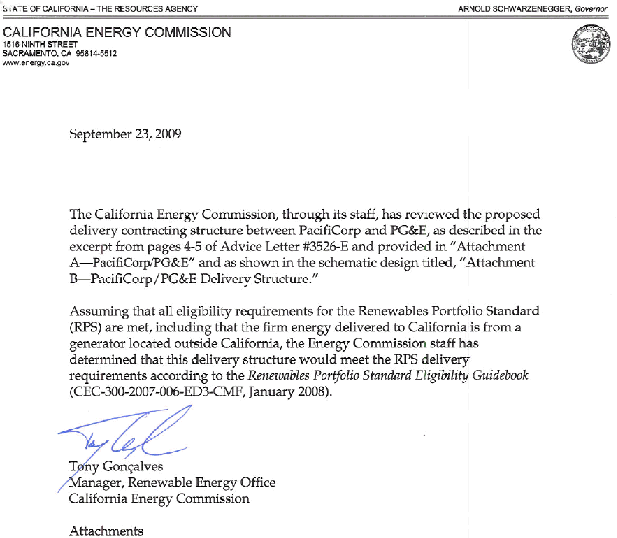
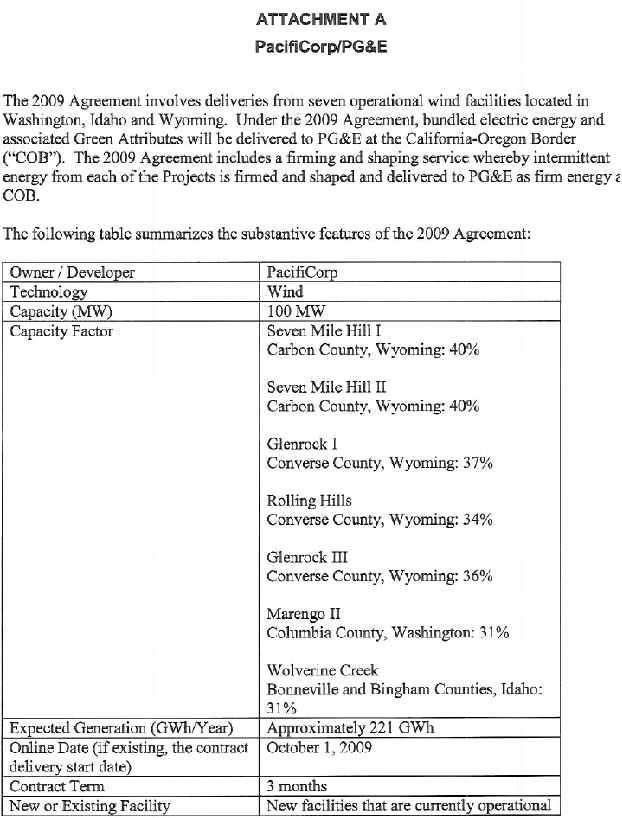
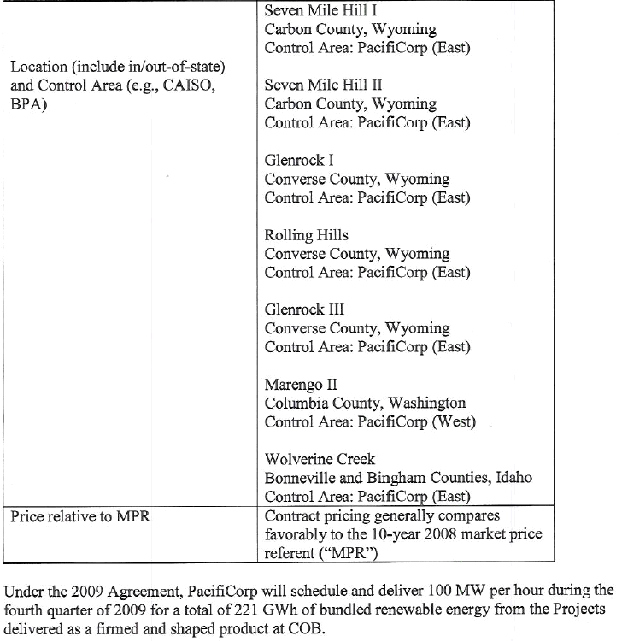
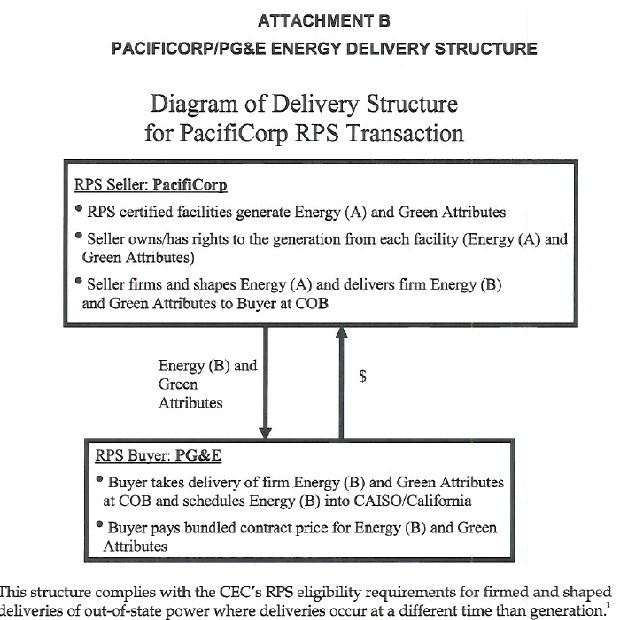
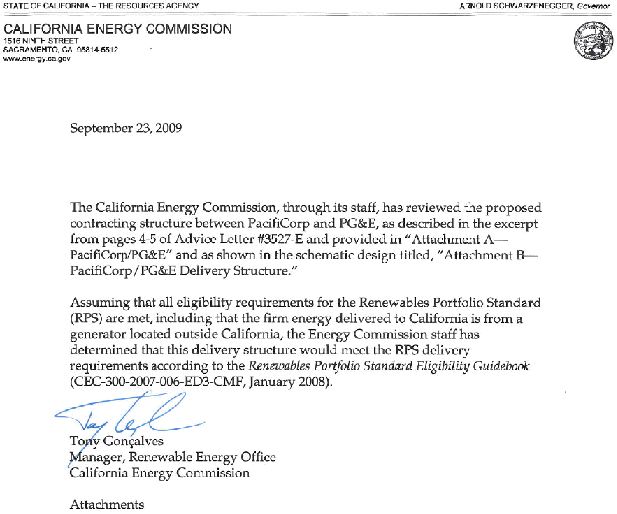
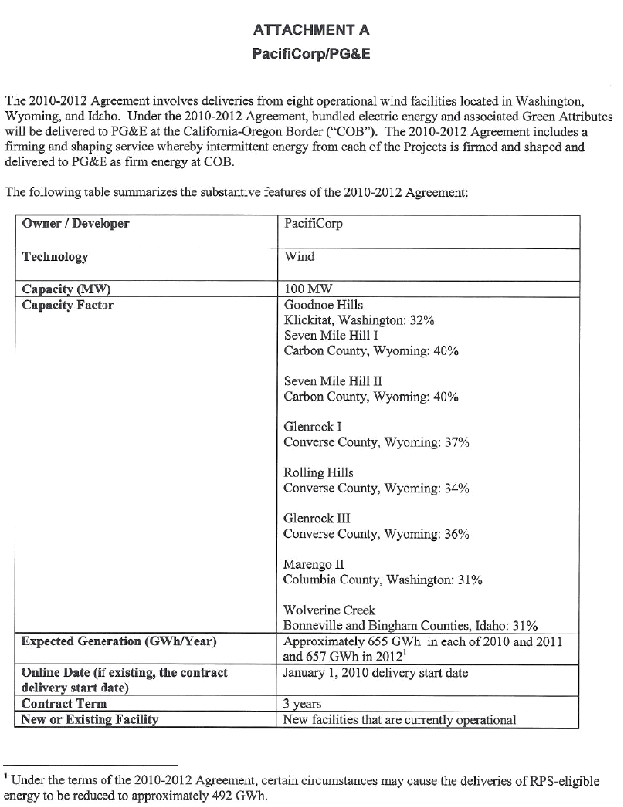
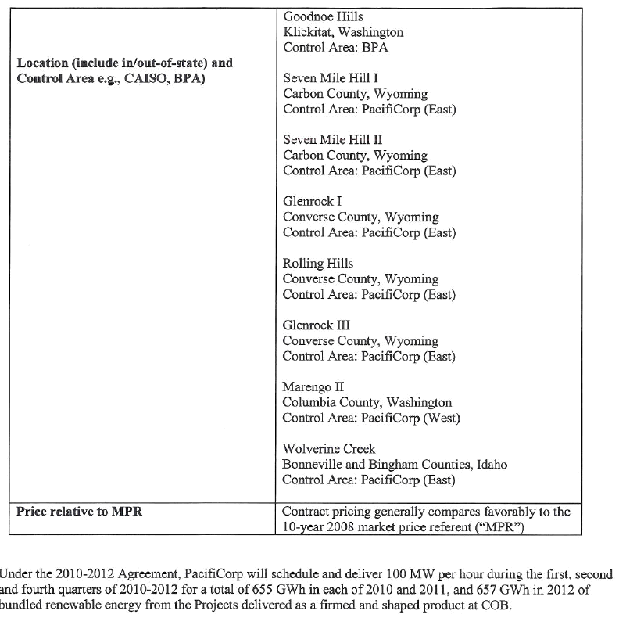
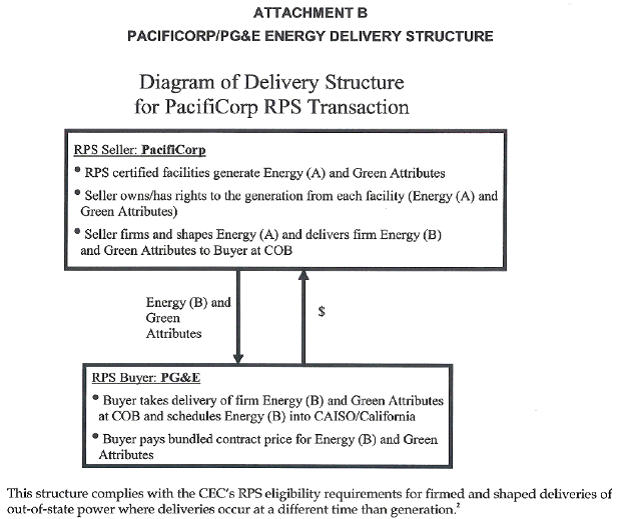
Confidential Appendix B
Contract Summary
[REDACTED]
1 On November 17, 2008, Governor Schwarzenegger signed Executive Order S-14-08, which established a 33 percent PRS target by 2020.
2 RPS decisions are available on the Commission's RPS website: http://www.cpuc.ca.gov/PUC/energy/Renewables/decisions.htm
3 MPR resolutions are available here: http://www.cpuc.ca.gov/PUC/energy/Renewables/mpr
4 Public Resources (PR) Code 25741(b)(2)(B)
5 Renewables Portfolio Standard (RPS) Eligibility Guidebook ( http://www.energy.ca.gov/2007publications/CEC-300-2007-006/CEC-300-2007-006-ED3-CMF.PDF) (THIRD Edition), publication # CEC-300-2007-006-ED3-CMF, January 2008.
6 Chapter 464, Statutes of 2006 (SB 1368)
7 D.07-01-039 adopted an emission rate of 1,100 pounds of carbon dioxide per megawatt-hour for the proxy CCGT (section 1.2, page 8) http://www.cpuc.ca.gov/WORD_PDF/FINAL_DECISION/64072.PDF
8 "Baseload generation" is electricity generation at a power plant "designed and intended to provide electricity at an annualized plant capacity factor of at least 60%." § 8340 (a)
9 California Public Utilities Code Section 399.11 et seq., as interpreted by D.03-07-061, the "Order Initiating Implementation of the Senate Bill 1078 Renewables Portfolio Standard Program", and subsequent Commission decisions in Rulemaking (R.) 04-04-026.
10 Pub. Util. Code, Section §399.14
11 Pub. Util. Code, Section §399.14(a)(3)
12 Contracts of less than 10 years duration are considered "short-term" contracts and facilities that commenced commercial operations prior to January 1, 2005 are considered "existing".
